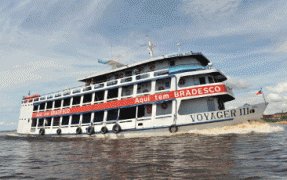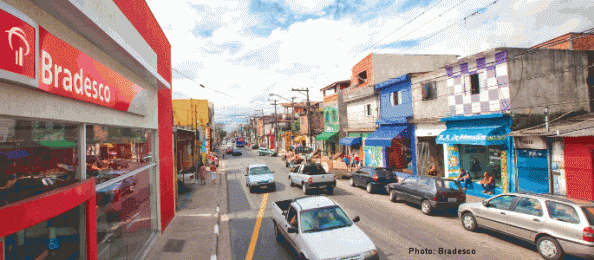Promoting Inclusion of the Population
Since its founding in 1943, Bradesco’s operations have been grounded in its commitment to Brazil’s development, and for that reason, sustainability is not new to Bradesco Bank. Issues such as community development and social inclusion have always been part of the organization’s day-to-day business.
In order to emphasize our strategic positioning, in 2007 Bradesco conceived the Banco do Planeta (Bank of the Planet) concept by which all of our socio-environmental actions are set under three key principles: sustainable finance, responsible governance, and socio-environmental investments.
In January 2010, Bradesco took a new important step and reformulated its vision and mission to reflect more explicitly its pursuit of sustainability. Thus, promoting inclusion of the population through universal and democratic access to bank products and services continues to be one of the major sources of inspiration for Bradesco’s practices in day-to-day business.
Bradesco’s presence
Bradesco is the only Brazilian bank present in all 5,565 municipalities of the country. This is a key factor considering Brazil’s continental dimensions of more than 8 million sq km with many areas that are difficult to reach. In providing the population access to bank products and services – particularly the more needy communities – Bradesco contributes toward fostering local trade and supporting local economies in the effort to aid in the country’s development.
As of December 2010, there are 41,053 Bradesco service points, including branches, PABs (banking service posts), ATMs, Bradesco Express locations (correspondent banking), and Bradesco Banco Postal (a partnership between Bradesco and the postal system).
In the last years, an average of 8,000 accounts have been opened every day. Our efforts toward inclusion are made evident by the fact that, of all individual account holders in our organization (21.8 million), 31 percent belong to social classes D and E: with family income averaging R$689.47 for class E, and between R$689.48 and R$1,135.98 for class D. Our total individual and business client base increased from 20.9 million in 2009 to 23.1 million in 2010. More than 300,000 new client accounts for people in class D and E were open in 2010, representing 33.7 percent of the Brazilian population. The bank aims to open more than 300,000 accounts in 2011 for clients in this segment.

Photo Bradesco
In order to strengthen our pursuit of banking inclusion, in 2009 Bradesco opened the first floating bank branch in the country. It is a branch of the bank kept on board of the Voyager III, a boat with a capacity for 500 tons of cargo and 200 passengers that navigates along the bank of the 1,600 km Solimoes River in the Amazon State, covering 11 municipalities and 50 communities. The idea is to provide for that population of around 250,000 people living in one of the regions of the country most difficult to reach. People along the bank of the Solimoes River are used to traveling for more than 12 hours to get their salaries, pensions, and Bolsa Família (Brazilian Government Family Forest Grant Program for needy families).
Set on a boat, the branch can receive and send data via satellite through an antenna on the boat. This enables the floating branch to send and receive bank data even when the boat is traveling. The branch makes it possible to provide the riverbank population with services that had not been available to them before. Clients can open an account, make deposits and withdrawals, pay bills, contract loans (at lower interest rates than on the market), recharge prepaid mobiles, and apply for credit cards. This initiative was highlighted on the cover of the Wall Street Journal on March 16, 2010.
Products and services within reach
To achieve inclusion in the banking system and make it feasible, it is not enough just to be present – it is important to be able to count on adequate products and services to match each client’s profile so that more and more citizens can access the banking system. Here are some of the products we offer:
Loans for low-income clients: In 2010, Bradesco achieved an R$1.86 billion balance from credit operations for class D and E clients. It represents a considerable increase of 20.45 percent over results from 2009.
Private Label cards: These cards are issued in partnership with a group of retailers to offer credit and other financial products to customers of those stores. Currently, the bank has more than 40 million active cards.
Mobile Bonus account: An innovative product for low-income people who still do not hold a current account. By purchasing the service, clients may convert all the Services Basket monthly fees into a bonus for calls and text messages on prepaid mobiles or into a current account.
Microinsurance: In 2010, Bradesco Vida e Previdência (Bradesco Life and Pension Plan) was the first to roll out in Brazil the Primeira Proteção Bradesco (Bradesco First Protection), a product adapted to the microinsurance concept, designed to meet the needs of people with lower purchasing power. The product covers personal accidents at a monthly cost of R$3.50, and covers up to R$20,000.00. In 2010 more than 560,000 insurance policies were sold. There is also the Vida Segura Bradesco (Bradesco Safe Life) insurance at a monthly cost of R$9.94, and Tranquilidade Familiar Bradesco (Bradesco Family Tranquility) at a monthly cost of R$5.98.
Educating about finance
Bradesco understands that it is also of utmost importance to contribute to educating the population about finance so that everyone can use bank products and services properly.
In 2010 free courses on personal finance, financial math, and Office Packages were made available on Bradesco’s website. However, there are many people in the country who have no access to the Internet. For this reason, the bank has held a series of “Encontros Municipais de Credito” (Municipal Meetings on Credit) in small towns, wherein the bank is introduced to people who, for most of their lives, have never had any contact with a financial institution.
Acknowledgement
As a result of our evolutionary process, society and markets have acknowledged Bradesco through various distinctions and awards. In addition to the awards, we would like to highlight:
- For the fifth consecutive year, the bank is included on the New York Stock Exchange’s (NYSE) Dow Jones Sustainability World Index (DJSI World).
- For the sixth consecutive year, the bank is part of BM&FBovespa’s ISE portfolio (Corporate Sustainability Index of Brazilian Mercantile and Futures Exchange on the Sao Paulo Stock Exchange).
- In 2010, Bradesco became part of the newly created ICO2 (Efficient Carbon Index), which aims to encourage the most traded companies on the stock exchange to gauge, monitor, and publish information on their greenhouse gas emissions. The Index is compiled by the BM&FBovespa and the BNDES (The Brazilian Economic and Social Development Bank).
Eduardo Dantas works for Bradesco in Brazil.
About Us // Privacy Policy // Copyright Information // Legal Disclaimer // Contact
Copyright © 2012-2018 macondo publishing GmbH. All rights reserved.
The CSR Academy is an independent learning platform of the macondo publishing group.









